Modeling Water Quality Parameters Using Data-Driven Models, a Case Study Abu-Ziriq Marsh in South of Iraq
Abstract
1. Introduction
2. Materials and Methods
2.1. Adaptive Neuro-Fuzzy Inference System
2.2. Artificial Neural Network
2.3. Multiple Linear Regression
3. Study Area and Data
3.1. Abu-Ziriq Marsh Description
3.2. Water Sampling Procedure
4. Performance Measures
- The Root Mean Squared Error (RMSE): RMSE is an error index type parameter commonly used in hydrological modeling:where is measured value, is number of data set and is predicted value. For RMSE, a value of zero is the optimum.
- Correlation Coefficient (CC): CC is a standard regression type parameter and defined as a measure of the strength of the linear relationship between the measured and predicted or estimated datasets:where N is the number of input samples; and are the measured and network output value from the elements, respectively. µ and and are their average, respectively.
- The Nash–Sutcliffe Coefficient of Efficiency (NSE): NSE is a dimensionless type parameter widely used as a metric of model efficiency [36]:
5. Results and Discussion
5.1. Model Structure
5.2. Models Performance
5.3. Sensitivity Analysis
6. Conclusions
Author Contributions
Funding
Acknowledgments
Conflicts of Interest
References
- Singh, K.P.; Malik, A.; Mohan, D.; Sinha, S. Multivariate statistical techniques for the evaluation of spatial and temporal variations in water quality of Gomti River (India)—A case study. Water Res. 2004, 38, 3980–3992. [Google Scholar] [CrossRef] [PubMed]
- Sattari, M.T.; Joudi, A.R.; Kusiak, A. Estimation of water quality parameters with data-driven model. J. Am. Water Works Assoc. 2016, 108, E232–E239. [Google Scholar] [CrossRef]
- Basant, N.; Gupta, S.; Malik, A.; Singh, K.P. Linear and nonlinear modeling for simultaneous prediction of dissolved oxygen and biochemical oxygen demand of the surface water—A case study. Chemom. Intell. Lab. Syst. 2010, 104, 172–180. [Google Scholar] [CrossRef]
- Dogan, E.; Sengorur, B.; Koklu, R. Modeling biological oxygen demand of the Melen River in Turkey using an artificial neural network technique. J. Environ. Manag. 2009, 90, 1229–1235. [Google Scholar] [CrossRef]
- Firat, M.; Güngör, M. Monthly total sediment forecasting using adaptive neuro fuzzy inference system. Stoch. Environ. Res. Risk Assess. 2010, 24, 259–270. [Google Scholar] [CrossRef]
- Kashani, M.H.; Dinpashoh, Y. Evaluation of efficiency of different estimation methods for missing climatological data. Stoch. Environ. Res. Risk Assess. 2012, 26, 59–71. [Google Scholar] [CrossRef]
- Verma, A.; Wei, X.; Kusiak, A. Predicting the total suspended solids in wastewater: A data-mining approach. Eng. Appl. Artif. Intell. 2013, 26, 1366–1372. [Google Scholar] [CrossRef]
- Wang, Y.; Guo, S.; Chen, H.; Zhou, Y. Comparative study of monthly inflow prediction methods for the Three Gorges Reservoir. Stoch. Environ. Res. Risk Assess. 2014, 28, 555–570. [Google Scholar] [CrossRef]
- Yilmaz, I.; Kaynar, O. Multiple regression, ANN (RBF, MLP) and ANFIS models for prediction of swell potential of clayey soils. Expert Syst. Appl. 2011, 38, 5958–5966. [Google Scholar] [CrossRef]
- Zaman Zad Ghavidel, S.; Montaseri, M. Application of different data-driven methods for the prediction of total dissolved solids in the Zarinehroud basin. Stoch. Environ. Res. Risk Assess. 2014, 28, 2101–2118. [Google Scholar] [CrossRef]
- Chen, W.B.; Liu, W.C. Artificial neural network modeling of dissolved oxygen in reservoir. Environ. Monit. Assess. 2014, 186, 1203–1217. [Google Scholar] [CrossRef]
- Kim, S. Nonlinear hydrologic modeling using the stochastic and neural networks approach. Disaster Adv. 2011, 4, 53–63. [Google Scholar]
- Kuo, J.-T.; Hsieh, M.-H.; Lung, W.-S.; She, N. Using artificial neural network for reservoir eutrophication prediction. Ecol. Model. 2007, 200, 171–177. [Google Scholar] [CrossRef]
- Wei, X.; Kusiak, A.; Sadat, H.R. Prediction of influent flow rate: Data-mining approach. J. Energy Eng. 2012, 139, 118–123. [Google Scholar] [CrossRef]
- Nemati, S.; Fazelifard, M.H.; Terzi, Ö.; Ghorbani, M.A. Estimation of dissolved oxygen using data-driven techniques in the Tai Po River, Hong Kong. Environ. Earth Sci. 2015, 74, 4065–4073. [Google Scholar] [CrossRef]
- Khudair, B.H. Water Quality Assessment and Total Dissolved Solids Prediction using Artificial Neural Network in Al-Hawizeh Marsh South of Iraq. J. Eng. 2018, 24, 147–156. [Google Scholar]
- Kanda, E.K.; Kipkorirb, E.C.; Kosgei, J.R. Dissolved Oxygen Modelling Using Artificial Neural Network: A Case of River Nzoia, Lake Victoria Basin, Kenya. J. Water Secur. 2016, 2, 1–7. [Google Scholar]
- Kisi, O.; Murat, A. Comparison of Ann and Anfis Techniques in Modeling Dissolved Oxygen. In Proceedings of the Sixteenth International Water Technology Conference (IWTC 16), Istanbul, Turkey, 7–10 May 2012. [Google Scholar]
- Salari, M.; Salami Shahid, E.; Afzali, S.H.; Ehteshami, M.; Conti, G.O.; Derakhshan, Z.; Sheibani, S.N. Quality assessment and artificial neural networks modeling for characterization of chemical and physical parameters of potable water. Food Chem. Toxicol. 2018, 118, 212–219. [Google Scholar] [CrossRef] [PubMed]
- GAO, L.; LI, D. A review of hydrological/water-quality models. Front. Agric. Sci. Eng. 2015, 1, 267. [Google Scholar] [CrossRef]
- Tutmez, B.; Hatipoglu, Z.; Kaymak, U. Modelling electrical conductivity of groundwater using an adaptive neuro-fuzzy inference system. Comput. Geosci. 2006, 32, 421–433. [Google Scholar] [CrossRef]
- Singh, K.P.; Basant, A.; Malik, A.; Jain, G. Artificial neural network modeling of the river water quality—A case study. Ecol. Model. 2009, 220, 888–895. [Google Scholar] [CrossRef]
- Wen, X.; Fang, J.; Diao, M. Artificial neural network modeling of dissolved oxygen in the Heihe River, Northwestern China. Environ. Monit. Assess. 2013, 185, 4361–4371. [Google Scholar] [CrossRef]
- Montaseri, M.; Zaman Zad Ghavidel, S.; Sanikhani, H. Water quality variations in different climates of Iran: Toward modeling total dissolved solid using soft computing techniques. Stoch. Environ. Res. Risk Assess. 2018, 32, 2253–2273. [Google Scholar] [CrossRef]
- Orouji, H.; Bozorg Haddad, O.; Fallah-Mehdipour, E.; Mariño, M.A. Modeling of Water Quality Parameters Using Data-Driven Models. J. Environ. Eng. 2013, 139, 947–957. [Google Scholar] [CrossRef]
- Ay, M.; Kişi, Ö. Estimation of dissolved oxygen by using neural networks and neuro fuzzy computing techniques. KSCE J. Civ. Eng. 2017, 21, 1631–1639. [Google Scholar] [CrossRef]
- Jang, J.-S. ANFIS: Adaptive-network-based fuzzy inference system. IEEE Trans. Syst. Man. Cybern. 1993, 23, 665–685. [Google Scholar] [CrossRef]
- Takagi, T.; Sugeno, M. Fuzzy identification of systems and its applications to modeling and control. IEEE Trans. Syst. Man. Cybern. 1985, SMC-15, 116–132. [Google Scholar] [CrossRef]
- Lin, C.-T.; Lee, C.S.G. Neural Fuzzy Systems: A Neuro-Fuzzy Synergism to Intelligent Systems; Prentice Hall PTR: Upper Saddle River, NJ, USA, 1996; Volume 205. [Google Scholar]
- Haykin, S. Neural Networks: A Comprehensive Foundation, 2nd ed.; Prentice Hall: Upper Saddle River, NJ, USA, 1999. [Google Scholar]
- Melesse, A.M.; Hanley, R.S. Artificial neural network application for multi-ecosystem carbon flux simulation. Ecol. Model. 2005, 189, 305–314. [Google Scholar] [CrossRef]
- Bilgili, M.; Sahin, B.; Yasar, A. Application of artificial neural networks for the wind speed prediction of target station using reference stations data. Renew. Energy 2007, 32, 2350–2360. [Google Scholar] [CrossRef]
- Mac Berthouex, P.; Brown, LC. Statistics for Environmental Engineers; Lewis Publishers: Boca Raton, FL, USA, 2002. [Google Scholar]
- Barzegar, R.; Adamowski, J.; Moghaddam, A.A. Application of wavelet-artificial intelligence hybrid models for water quality prediction: A case study in Aji-Chay River, Iran. Stoch. Environ. Res. Risk Assess. 2016, 30, 1797–1819. [Google Scholar] [CrossRef]
- Ghorbani, M.A.; Khatibi, R.; Hosseini, B.; Bilgili, M. Relative importance of parameters affecting wind speed prediction using artificial neural networks. Theor. Appl. Climatol. 2013, 114, 107–114. [Google Scholar] [CrossRef]
- Srinivasulu, S.; Jain, A. A comparative analysis of training methods for artificial neural network rainfall–runoff models. Appl. Soft Comput. 2006, 6, 295–306. [Google Scholar] [CrossRef]
- Bracewell, R. “Pentagram Notation for Cross Correlation.” The Fourier Transform and Its Applications; McGraw-Hill: New York, NY, USA, 1965; pp. 46, 243. [Google Scholar]
- Abdulshahed, A.M.; Longstaff, A.P.; Fletcher, S. The application of ANFIS prediction models for thermal error compensation on CNC machine tools. Appl. Soft Comput. 2015, 27, 158–168. [Google Scholar] [CrossRef]
- Al-Mukhtar, M. Integrated Approach to Forecast Future Suspended Sediment Load by Means of SWAT and Artificial Intelligence Models, a Case Study. Freiberg Online Geosci. 2018, 51, 52–77. [Google Scholar]
- Khadr, M.; Elshemy, M. Data-driven modeling for water quality prediction case study: The drains system associated with Manzala Lake, Egypt. Ain Shams Eng. J. 2017, 8, 549–557. [Google Scholar] [CrossRef]
- Tofigh, A.A.; Rahimipour, M.R.; Shabani, M.O.; Davami, P. Application of the combined neuro-computing, fuzzy logic and swarm intelligence for optimization of compocast nanocomposites. J. Compos. Mater. 2015, 49, 1653–1663. [Google Scholar] [CrossRef]
- Kosko, B. Fuzzy Engineering; Prentice-Hall: Upper Saddle River, NJ, USA, 1997. [Google Scholar]
- Heddam, S. Modeling hourly dissolved oxygen concentration (DO) using two different adaptive neuro-fuzzy inference systems (ANFIS): A comparative study. Environ. Monit. Assess. 2014, 186, 597–619. [Google Scholar] [CrossRef] [PubMed]
- Najah, A.; El-Shafie, A.; Karim, O.A.; El-Shafie, A.H. Performance of ANFIS versus MLP-NN dissolved oxygen prediction models in water quality monitoring. Environ. Sci. Pollut. Res. 2014, 21, 1658–1670. [Google Scholar] [CrossRef]
- Borgonovo, E.; Plischke, E. Sensitivity Analysis: A Review of Recent Advances. Eur. J. Oper. Res. 2015. [Google Scholar] [CrossRef]
- Rajaee, T.; Mirbagheri, S.A.; Zounemat-Kermani, M.; Nourani, V. Daily suspended sediment concentration simulation using ANN and neuro-fuzzy models. Sci. Total Environ. 2009, 407, 4916–4927. [Google Scholar] [CrossRef]
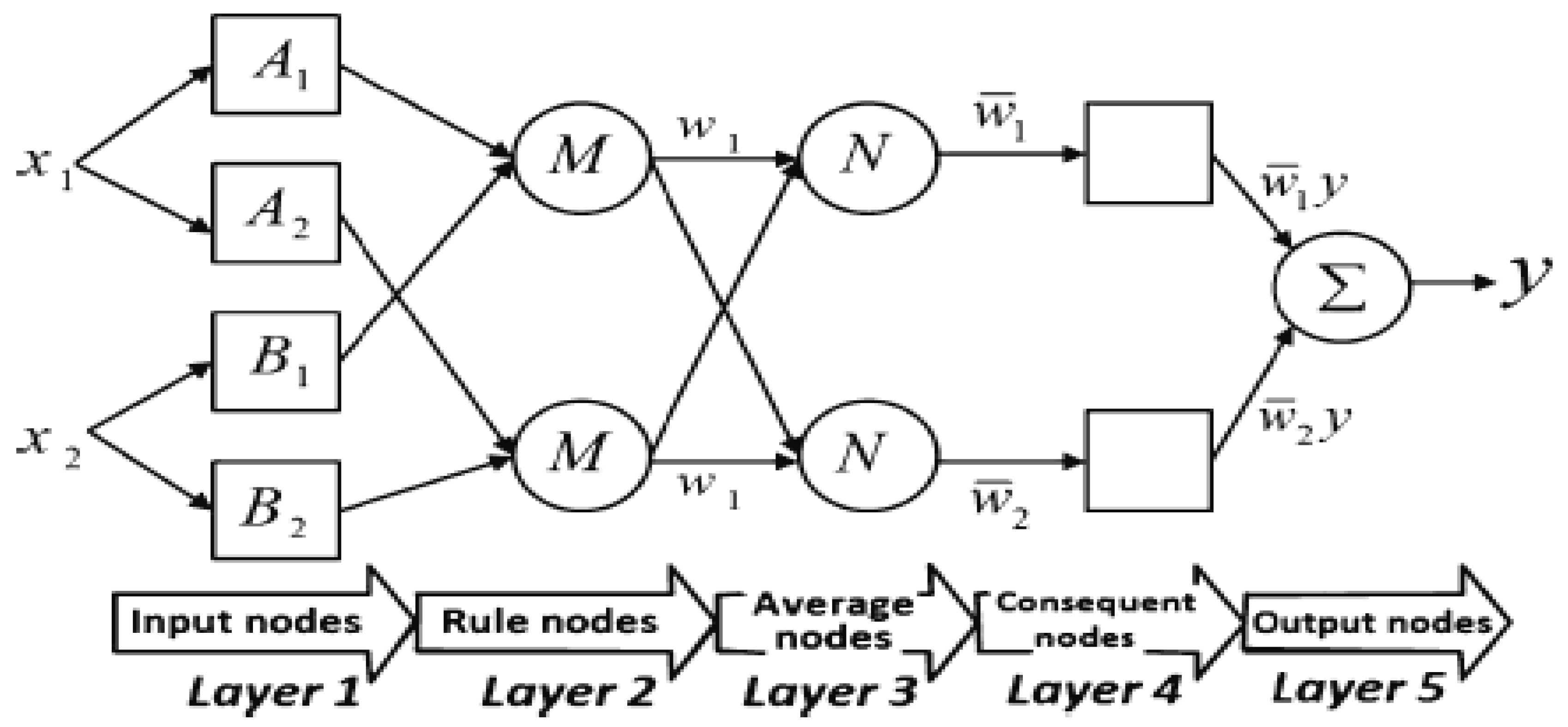
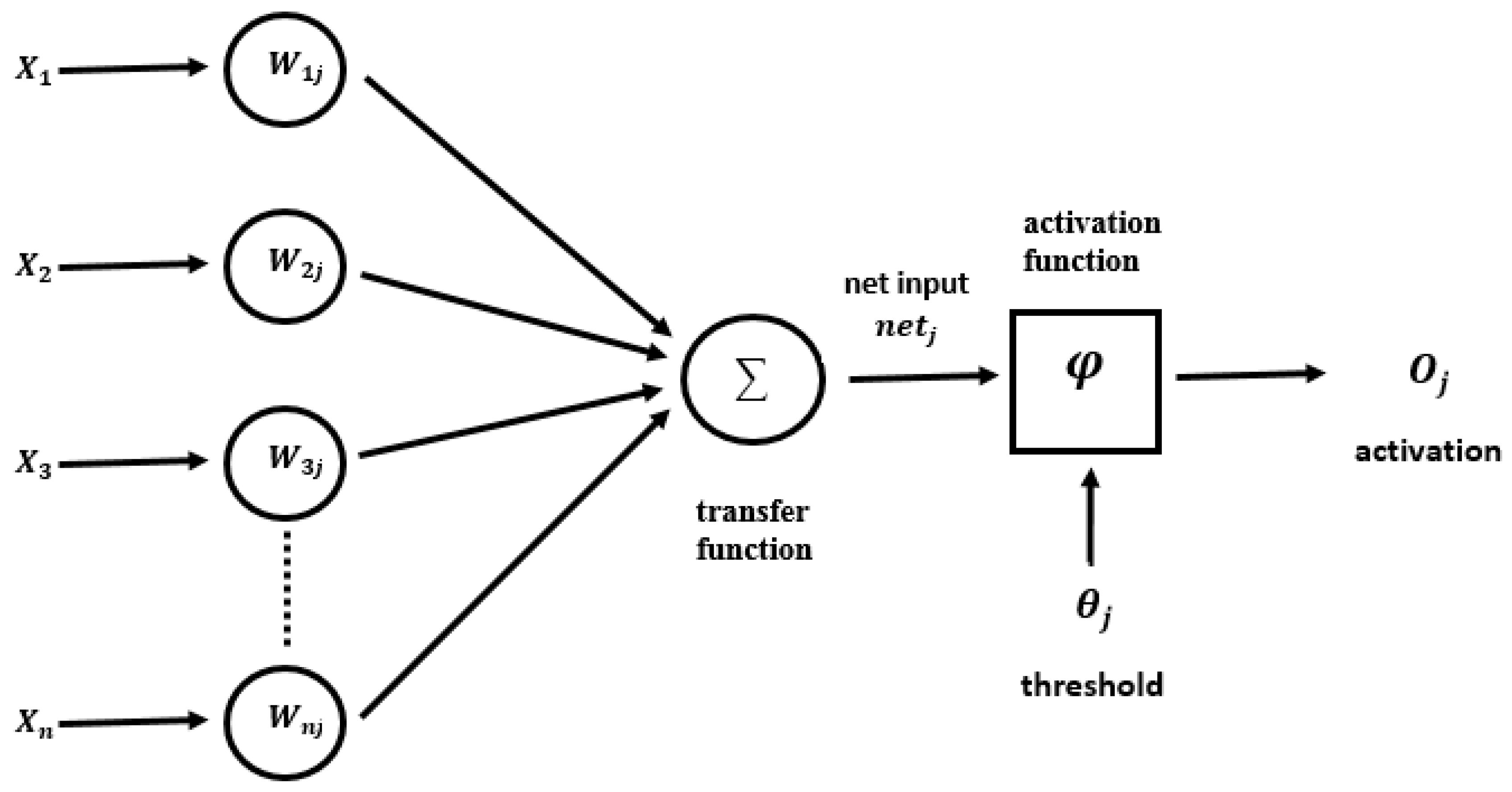
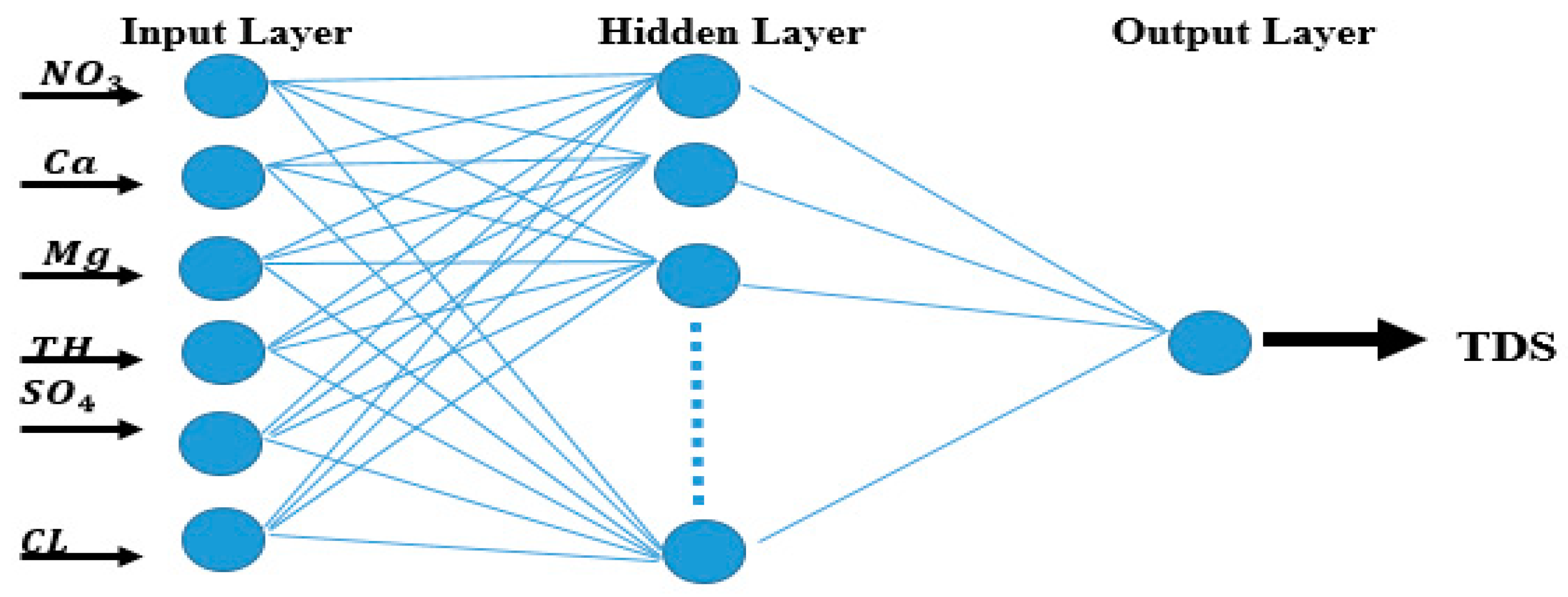

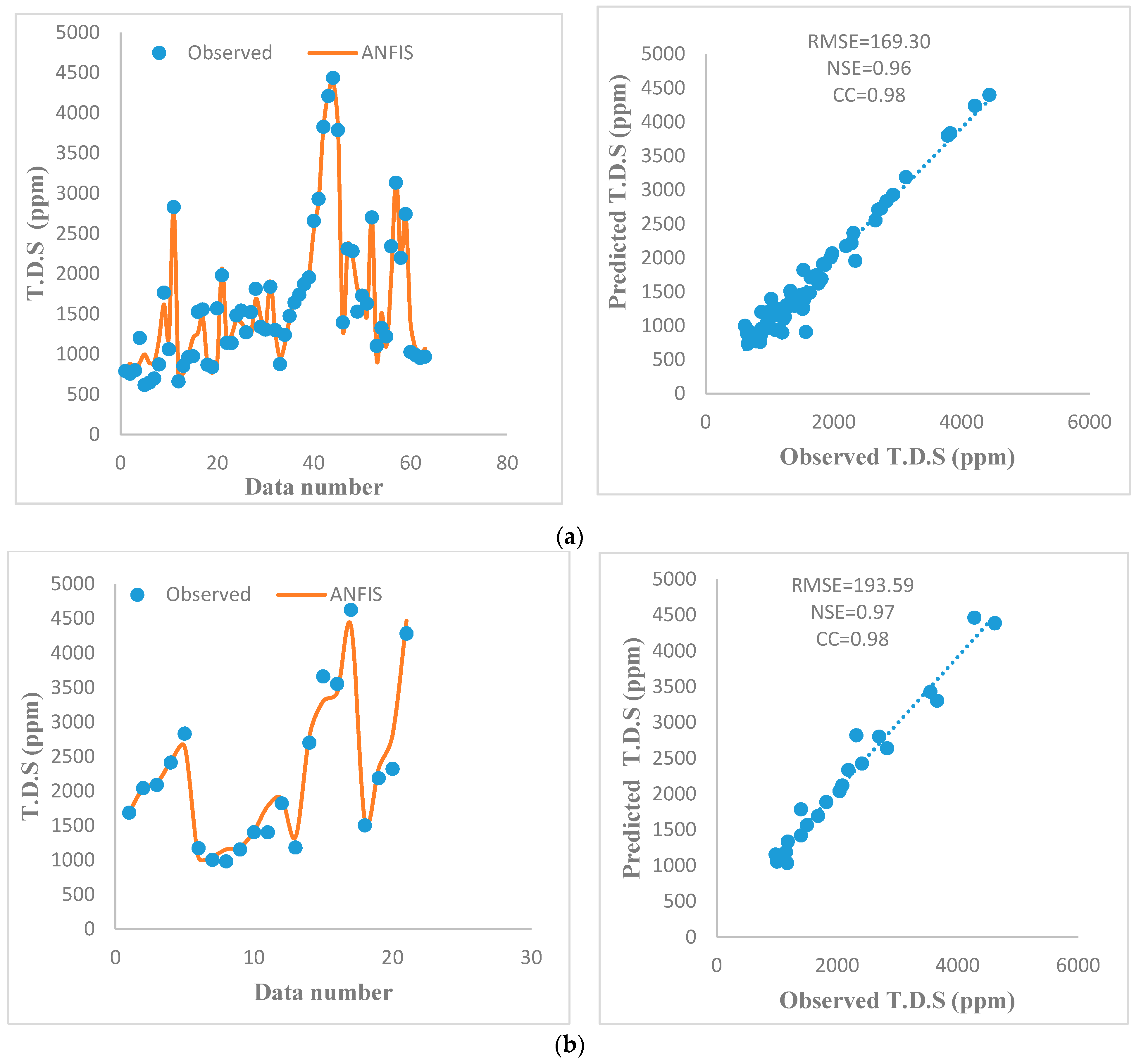

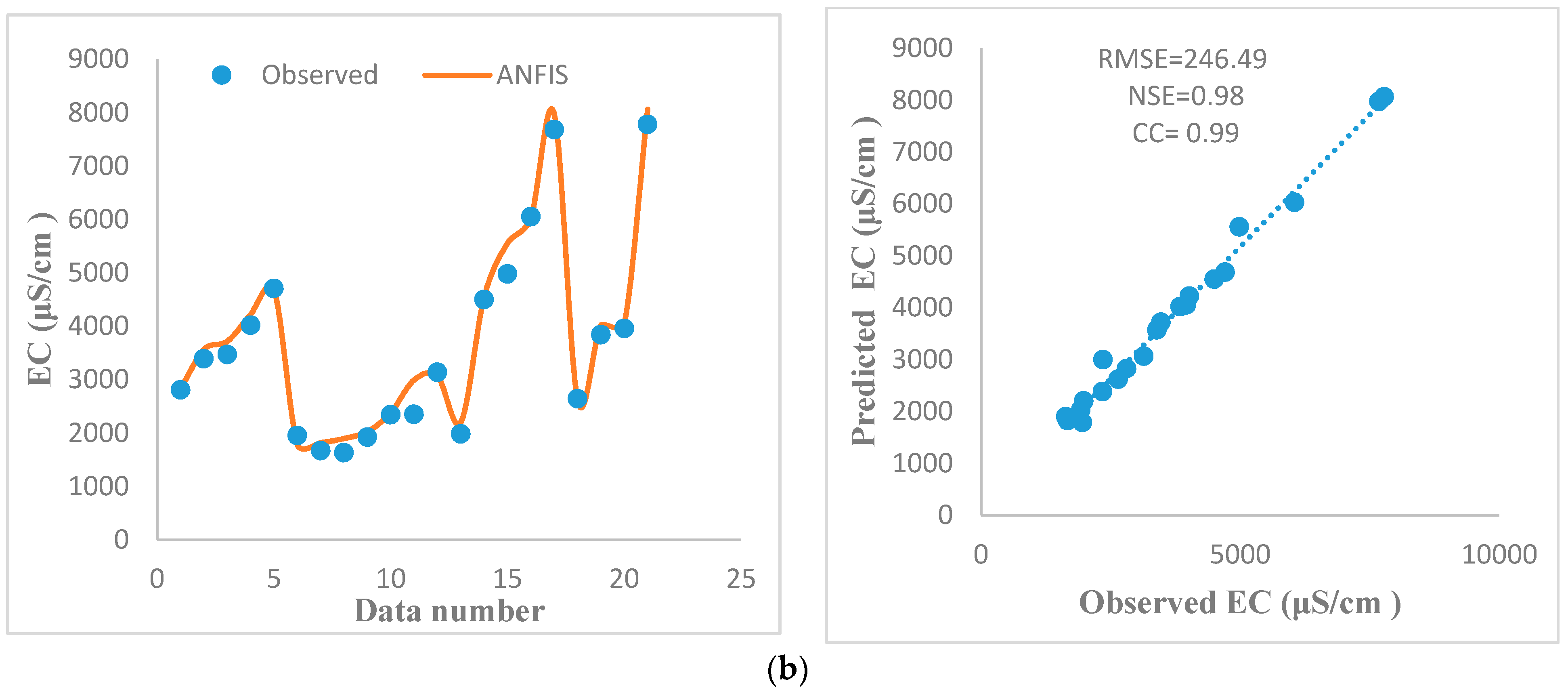
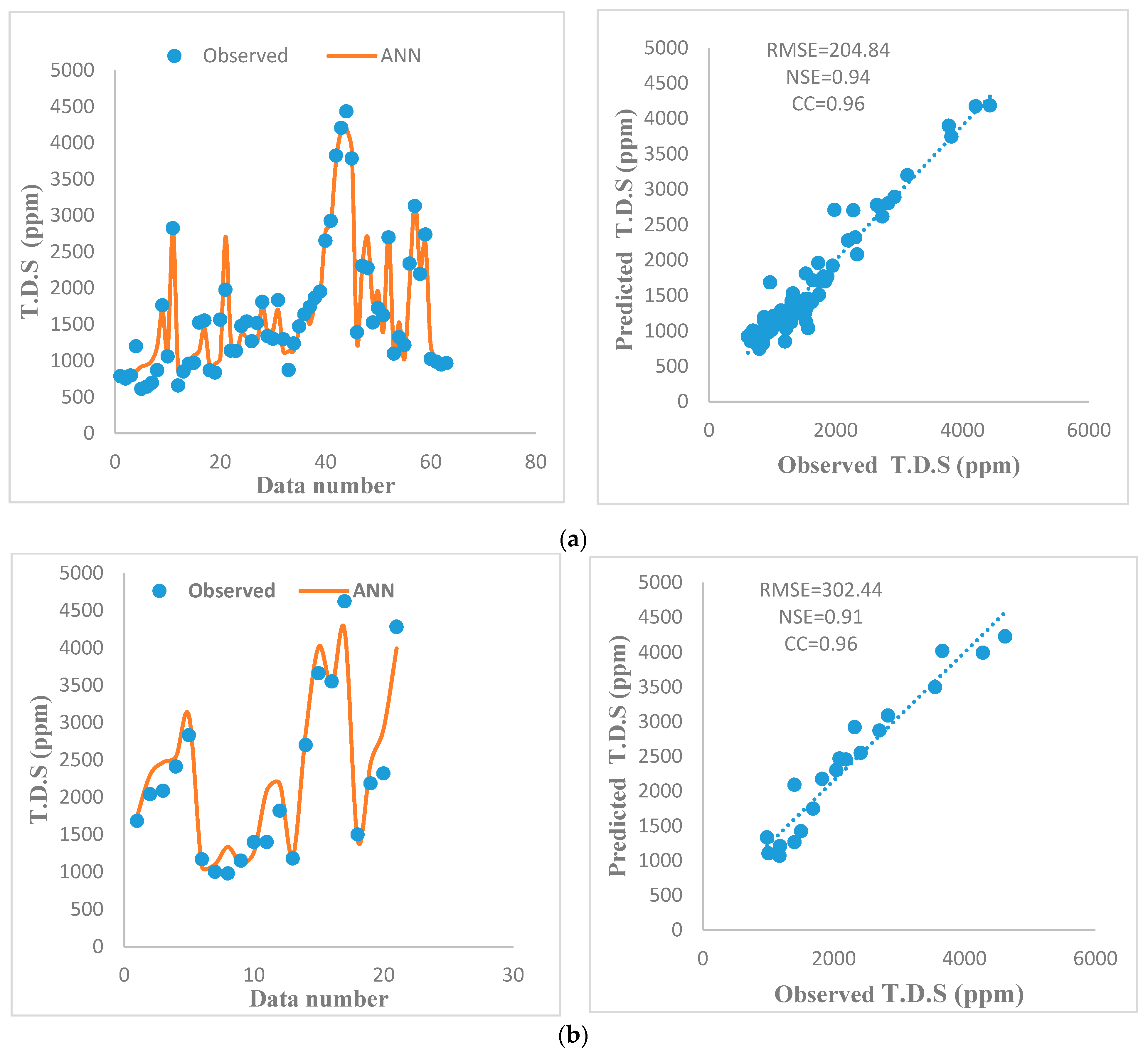
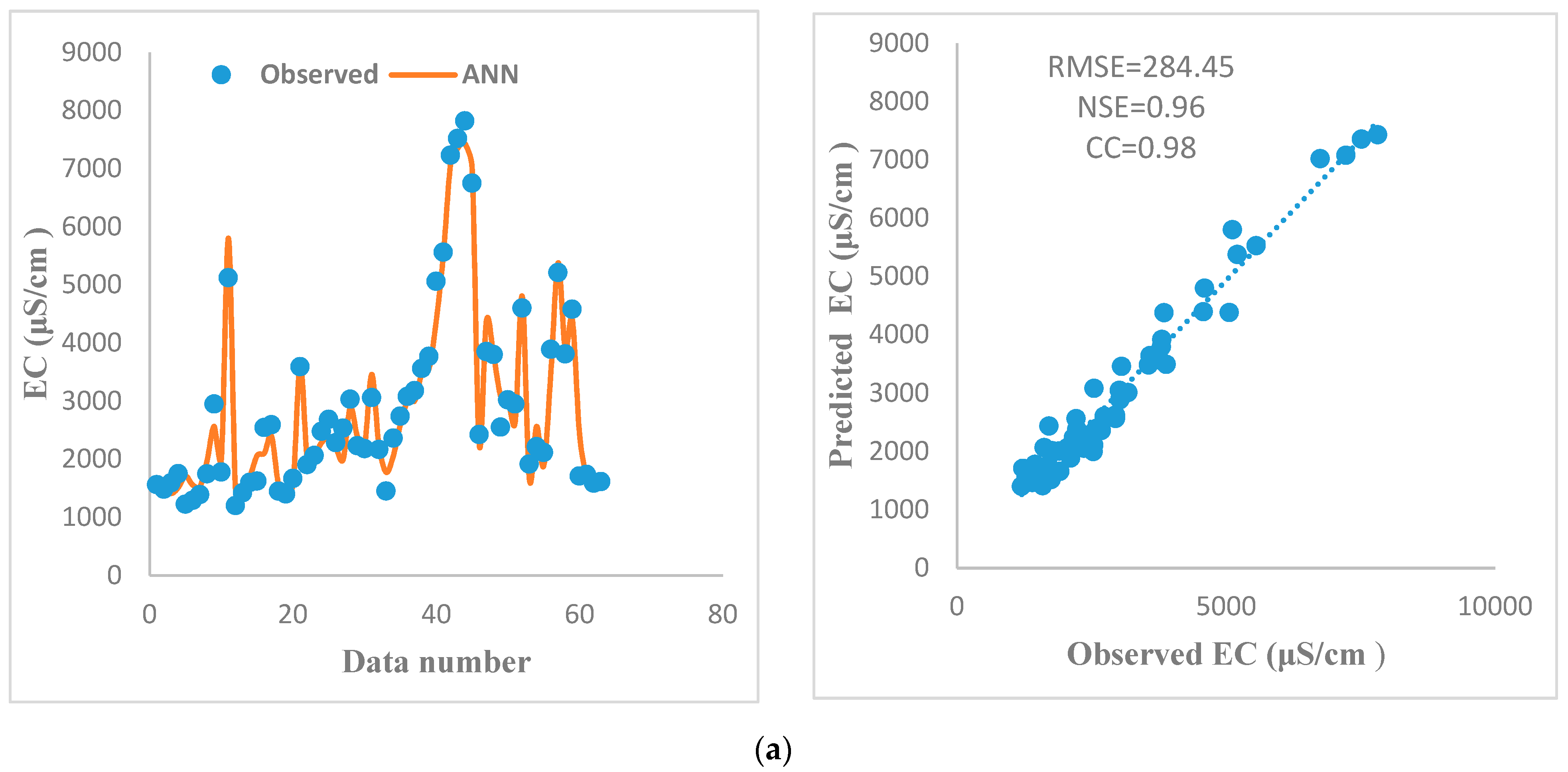

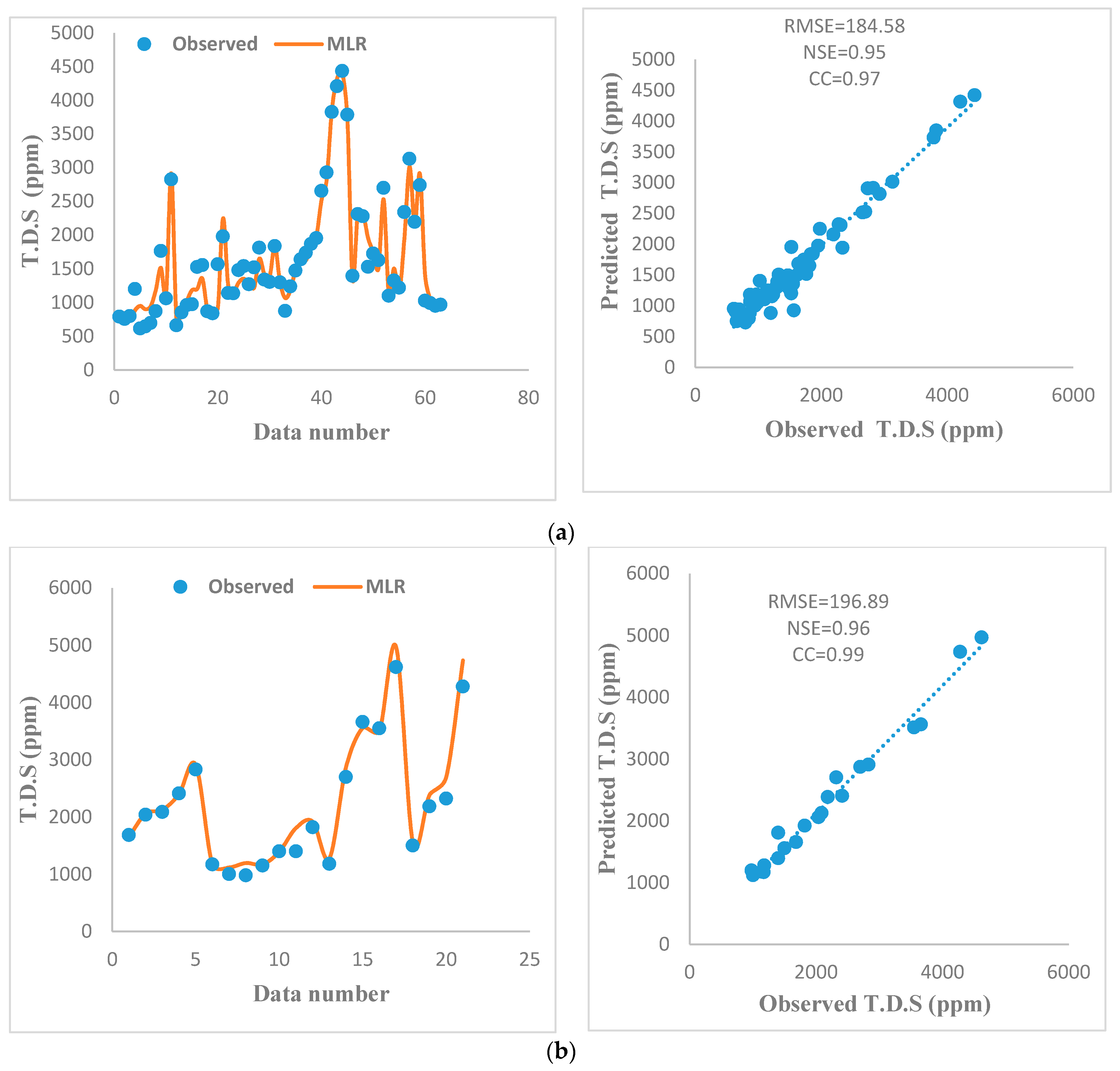
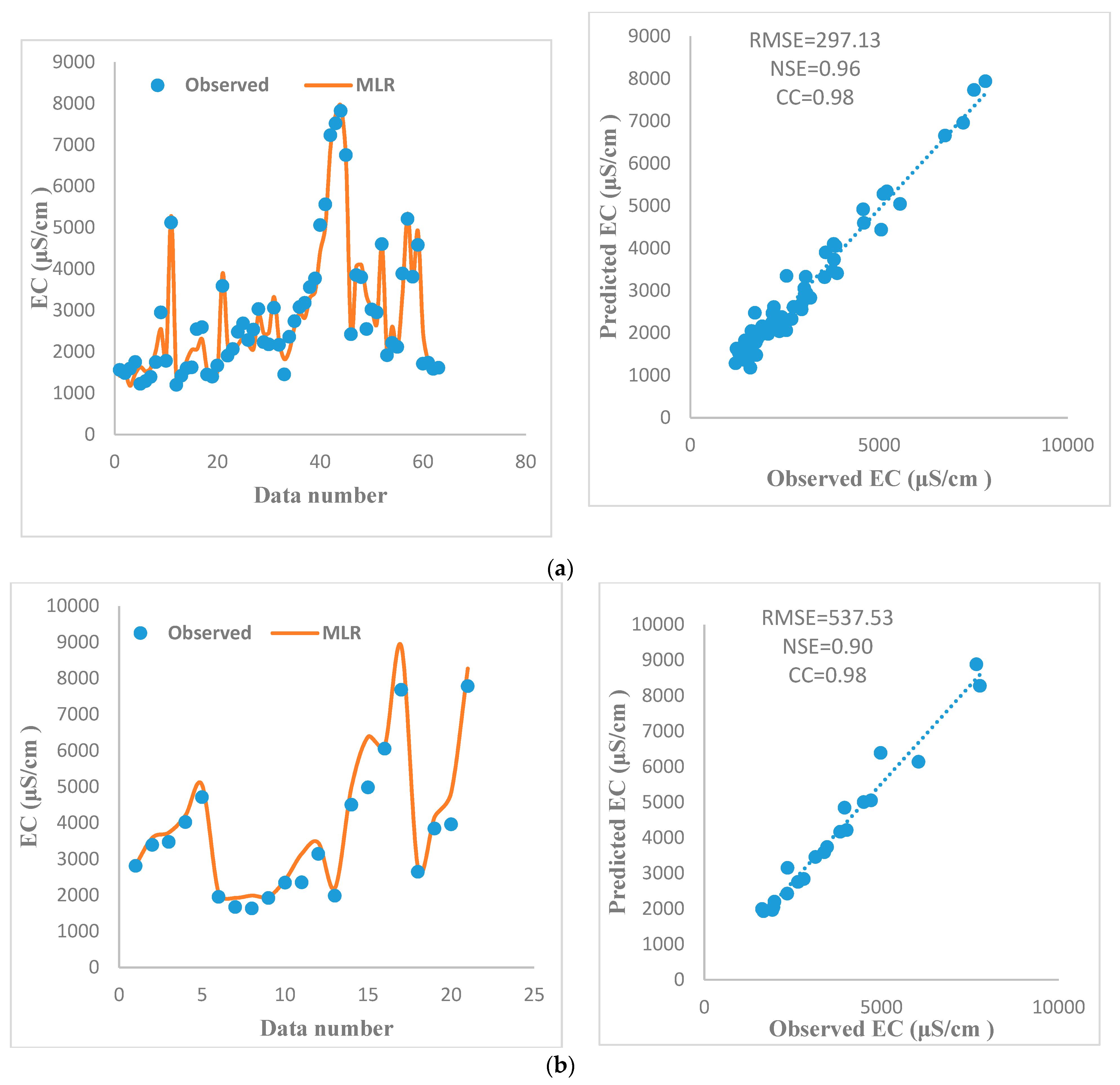
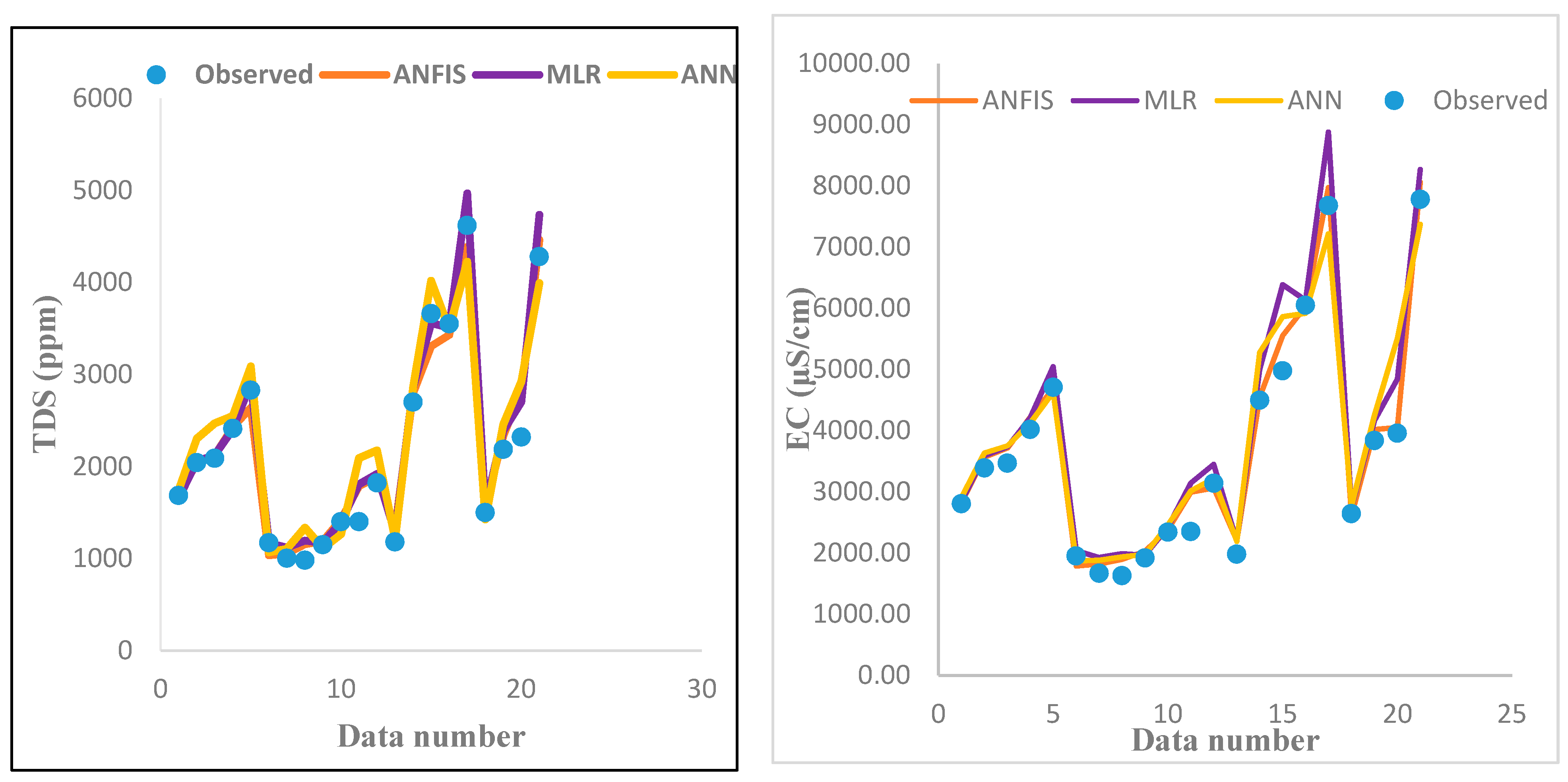
| Year | 2009 | 2010 | 2013 | 2014 | 2015 | 2016 | 2017 | 2018 |
|---|---|---|---|---|---|---|---|---|
| Sample of data | 11 | 9 | 12 | 12 | 12 | 8 | 12 | 8 |
| Variable | Unit | Range | Min | Max | Mean | SD | CV% |
|---|---|---|---|---|---|---|---|
| ppm | 3.50 | 0.30 | 3.80 | 1.45 | 0.52 | 0.27 | |
| ppm | 736 | 64 | 800 | 160.84 | 94.52 | 8935 | |
| ppm | 310 | 20 | 330 | 97.58 | 65.49 | 4290.04 | |
| T.H | ppm | 1840 | 320 | 2160 | 783.20 | 394.79 | 155,866.64 |
| ppm | 1201 | 99 | 1300 | 430.25 | 278.25 | 77,427.58 | |
| Cl−1 | ppm | 1472 | 150 | 1622 | 481.28 | 312.45 | 97,626.15 |
| EC | µS/cm | 6620 | 1200 | 7820 | 3072.13 | 1676.71 | 2,811,366 |
| TDS | ppm | 4006 | 614 | 4620 | 1781.19 | 960.22 | 922,029.31 |
| Parameters | NO3 | Ca+2 | Mg+2 | T.H | SO4 | Cl−1 | EC | TDS |
|---|---|---|---|---|---|---|---|---|
| NO3 | 1 | |||||||
| Ca+2 | 0.225 | 1 | ||||||
| Mg+2 | 0.139 | 0.487 | 1 | |||||
| T.H | 0.149 | 0.582 | 0.943 | 1 | ||||
| SO4 | 0.103 | 0.559 | 0.878 | 0.894 | 1 | |||
| Cl−1 | 0.293 | 0.685 | 0.828 | 0.894 | 0.855 | 1 | ||
| EC | 0.193 | 0.640 | 0.887 | 0.922 | 0.930 | 0.955 | 1 | |
| TDS | 0.220 | 0.636 | 0.875 | 0.920 | 0.917 | 0.966 | 0.988 | 1 |
| Estimated | Model | Calibration | Validation | ||||
|---|---|---|---|---|---|---|---|
| RMSE | CC | NSE | RMSE | CC | NSE | ||
| TDS | MLR | 184.58 (ppm) | 0.97 | 0.95 | 196.89 (ppm) | 0.99 | 0.96 |
| ANN | 204.84 (ppm) | 0.96 | 0.94 | 302.14 (ppm) | 0.96 | 0.91 | |
| ANFIS | 169.30 (ppm) | 0.98 | 0.96 | 193.59 (ppm) | 0.98 | 0.97 | |
| EC | MLR | 297.13 (μS/cm) | 0.98 | 0.96 | 537.53 (μS/cm) | 0.98 | 0.90 |
| ANN | 284.45 (μS/cm) | 0.98 | 0.96 | 496.71 (μS/cm) | 0.97 | 0.92 | |
| ANFIS | 273.45 (μS/cm) | 0.98 | 0.97 | 246.49 (μS/cm) | 0.99 | 0.98 | |
| Input parameters | −10% | −20% | −30% | −40% | −50% | +10% | +20% | +30% | +40% | +50% |
| EC | 7.01 | 16.55 | 26.18 | 35.65 | 45.27 | −11.5 | −20.65 | −29.55 | −37.93 | −45.64 |
| TDS | 3.28 | 13.91 | 25.53 | 37.1 | 48.8 | −17.83 | −27.53 | −33.83 | −41.93 | −47.65 |
© 2019 by the authors. Licensee MDPI, Basel, Switzerland. This article is an open access article distributed under the terms and conditions of the Creative Commons Attribution (CC BY) license (http://creativecommons.org/licenses/by/4.0/).
Share and Cite
Al-Mukhtar, M.; Al-Yaseen, F. Modeling Water Quality Parameters Using Data-Driven Models, a Case Study Abu-Ziriq Marsh in South of Iraq. Hydrology 2019, 6, 24. https://doi.org/10.3390/hydrology6010024
Al-Mukhtar M, Al-Yaseen F. Modeling Water Quality Parameters Using Data-Driven Models, a Case Study Abu-Ziriq Marsh in South of Iraq. Hydrology. 2019; 6(1):24. https://doi.org/10.3390/hydrology6010024
Chicago/Turabian StyleAl-Mukhtar, Mustafa, and Fuaad Al-Yaseen. 2019. "Modeling Water Quality Parameters Using Data-Driven Models, a Case Study Abu-Ziriq Marsh in South of Iraq" Hydrology 6, no. 1: 24. https://doi.org/10.3390/hydrology6010024
APA StyleAl-Mukhtar, M., & Al-Yaseen, F. (2019). Modeling Water Quality Parameters Using Data-Driven Models, a Case Study Abu-Ziriq Marsh in South of Iraq. Hydrology, 6(1), 24. https://doi.org/10.3390/hydrology6010024





